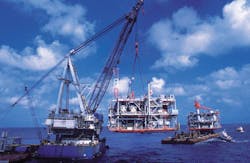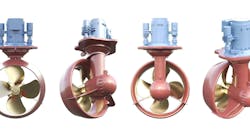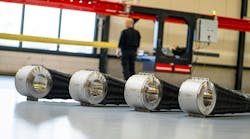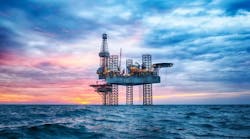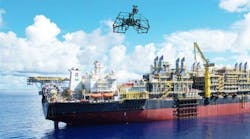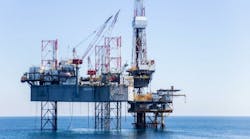New generation of deepwater lifts evolving
William Furlow
Technology Editor
The Heavy Lift Vessel DB-50 is shown here lifting the North module of the Petronius compliant tower into place. The ill fated South module is visible in the background.Before the lift cable broke on Derrick Barge 50 while installing the South Module on the Petronius compliant tower in the US Gulf of Mexico, the same vessel had installed the heavier North Module. The operator was acting within standard industry practice, yet the cable failed. What does this failure say about the future of heavy lifts in deepwater?
One thing that everyone seems to agree on is that the cable failure was not an engineering error. These lifts are calculated very carefully and taken seriously be everyone involved. A lift of this magnitude is a major undertaking, and sources say J. Ray McDermott "engineers the hell out of them."
While these modules weighed in close to the published capacity of the DB-50, that capacity has a broad margin of error. From an engineering stand point, this lift should have gone off without a hitch. While this information is reassuring on the one hand, it is also disturbing from the point of view that such a well engineered heavy lift could result in a total loss.
There are variables that have not been taken into consideration. Until these are identified and quantified, there will always be the possibility of another cable break. In the words of one industry expert, the only way to be sure such an accident will never happen again is to cease all heavy lift activities.
Why the failure
These are no hard fast rules governing heavy lift cables in the Gulf of Mexico. Each company has its own criteria for how long a cable is kept in service and even test lifts, designed to certify a vessel for a specific job, are not standardized. The cable that broke on the J. Ray McDermott vessel should not have been fatigued from performing earlier lifts.The 2.25-in. cable was designed to run through the 32 sheaves in the lifting block at an angle that does not plastically deform the cable because the angle does not exceed the bending radius of the cable. The only answer anyone seems to come up with is internal corrosion.
If salt or other corrosive materials were able to penetrate the cable, the core, which has less cross-sectional surface than the surrounding strands of cable, would be pitted and weakened. This corrosion would create a "hot spot stress" defect area. If this were the case then the formulas used to calculate the bending radius of the cable would no longer be valid. The cable would be weakened at the point of corrosion and prone to break under what would otherwise be normal use.
Assuming this is what happened on the DB 50 the question then becomes - what more can the industry do to protect against similar disasters in the future? While all the facts are not yet public, industry sources say McDermott appears to have done nothing wrong. In fact, the process followed for this lift could be considered typical of the practices followed in most areas of the world.
According to sources familiar with the process and the company, a visual inspection of the cable would most likely have missed internal corrosion because it is not generally visible on the cable surface. Experts in the testing field say there is no way to detect this sort of corrosion. Even if a sample of the cable were tested to failure prior to the lift, that step cannot guarantee there is no corrosion (hot-spot stress) in another cable section.
So how can such a problem be detected prior to failure? Either the industry will have to come up with a new method of inspecting a lift cable, one that would reveal internal corrosion, or incorporate the possibility of corrosion into the life expectancy of the cable.
Burden on operator
In heavy lift operations, the client, typically an operator, bears a remarkable amount of responsibility financially. If the lift requires a vessel upgrade, that must be paid for by the operator, and if the operator feels a test lift would be prudent, the operator must lay out the cash for this procedure. A test lift typically will involve the vessel lifting a water filled barge that simulates the weight of the upcoming lift. These test lifts are by no means mandatory. When the cost is considered, it is not surprising that few operators choose to pay for a test lift that is not required.If such a lift were performed on the Petronius project and if the break was indeed caused by internal corrosion, then the irony is that this expensive test lift would have contributed to fatiguing the hot-spot stress that broke the cable.
Typically, these cables are in service for about five years. At that point they are changed out and the old cable is often recycled as an anchor line. This procedure has been followed for decades with few incidents of cable breaks, but as the industry evolves, new stresses on cable can develop.
Deepwater lowering systems
One of the factors that may have contributed to the cable break on the DB-50 is the fact that the block was occasionally submerged during lifts. According to sources familiar with the business, it is not unusual for a heavy lift block to occasionally be submerged during a lift. While this submersion is very brief, it does expose the cable to salt water at every point where the cable is in contact with the sheaves in the block. Even temporary exposure could allow salt water to penetrate the coating of grease designed to protect the cable.With more deepwater subsea programs coming on line, subsea installation jobs are more and more common for McDermott and competitors. These companies have developed dedicated subsea lowering systems to meet this demand. The deepwater lowering systems are by definition fully submerged for lengths of time. At these extreme water depths, the cable is subjected to hydrostatic pressures that do not affect the cable strength, but may force corrosive sea water into the core of the cable.
What may be needed is a new industry standard that reflects the new environment in which these cables are working.
Copyright 1999 Oil & Gas Journal. All Rights Reserved.
